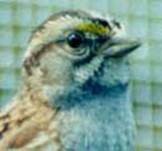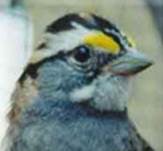You are here
Dr. Elaina M. Tuttle
Ph.D., State University of New York at Albany
For Information Contact: Rusty Gonser
Research Interests: behavioral ecology; avian mating systems; populations genetics.
Dr. Tuttle is interested in the evolution of behavior, populations, and species. Specifically, she examines how ecology, behavior, genetics, and physiology maintain natural variation through their influence on the evolution of life-history strategies, phenotypic expression, and both the relative fitness and frequency of genotypes within a population. Dr. Tuttle is currently involved in two projects that investigate these factors: 1) a study of the maintenance of polymorphism via disassortative mating in the white-throated sparrow (Zonotrichia albicollis), and 2) a study of sexual selection and the evolution of mating systems in Australian fairy-wrens (Malurus splendens, M. lamberti, M. leucopterus) in collaboration with Stephen Pruett-Jones (University of Chicago) and Michael S. Webster (Washington State University).
Dr. Tuttle's work on white-throated sparrows and fairy-wrens examines how individuals maximize fitness through the differential allocation of time, energy, and resources. Both research projects examine 1) how individuals balance various life history trade-offs, and 2) how life-history trade-offs generate variance that affects the evolution of sexually-selected characters. Dr. Tuttle's research differs from conventional evolutionary study in that she often employs concepts and techniques borrowed from other disciplines.
Dr. Tuttle utilizes observational and experimental methods in the field and laboratory, molecular genetic techniques (e.g. minisatellite DNA fingerprinting, microsatellites, RAPDs, AFLPs), physiological techniques (e.g. semen sampling, hormonal analyses, and immunological analyses), and other multi-disciplinary techniques (e.g. karyotyping, histology). An integrative approach often reveals new alternative hypotheses and allows her to investigate evolutionary questions at proximate and ultimate levels. 

Dr. Tuttle has a general interest in population genetics, the nature and organization of genetic variation in populations, and how genetic diversity affects the conservation of species. She has collaborated on several such research projects on a variety of organisms ranging from mammals to insects.
SELECTED PUBLICATIONS
Reprints for some publications are available as PDF files. By accessing the PDF file, the user agrees to abide by all copyright laws and education fair-use regulations.
Romanov, M.N., Tuttle, E.M., Houck, M.L., Modi, W.S., Chemnick, L.G., Korody, M.L., Stemel, E., Jones, K.C., Dandekar, S., Papp, J., Da, Y., NISC Comparative Sequencing Program, Green, E.D., Magrini, V., Hickenbotham, M.T., Glasscock, J., McGrath, S., Mardis, E.R., & Ryder, O.A. 2009. The value of avian genomics to the conservation of wildlife. BMC Genomics. in press.
Hoffman, A.M., Song, J., & Tuttle, E.M. 2008. ELOPTA: A Novel Microcontroller Based Operant Device. Behavior Research Methods 39(4): 776-782.
Webster, M., Tarvin K., Tuttle, E.M., & Pruett-Jones, S. 2007. Nest predation increases the strength of sexual selection in a monogamous bird. Evolution 71(9): 2205-2211.
Tuttle, E.M., Jensen, R.R., Formica, V.A., & Gonser, R.A. 2006. Using remote sensing image texture to study habitat use patterns: A case study using the polymorphic white-throated sparrow (Zonotrichia albicollis). Global Ecology and Biogeography 15: 349-357. ![]() Download PDF - (163 Kb)
Download PDF - (163 Kb)
Hoffman, A.M., Robakiewicz, P.E., Tuttle, E.M., & Rogers, L.J. 2006. Behavioural lateralisation in the Australian magpie (Gymnorhina tibicen). Laterality 11(2): 110-121.
Tarvin, K.A., Webster, M.W., Tuttle, E.M., & Pruett-Jones, S. 2005. Extra-pair mating is influenced by genetic similarity in splendid fairy-wrens. Animal Behavior 70: 945-955. PDF (241 Kb)
Stutchbury, B.J.M., Pitcher, T.E., Norris, D.R., Tuttle, E.M., & Gonser, R.A. 2005. Does male extra-territory foray effort affect within and extra-pair fertilization success in hooded warblers, Wilsonia citrina? Journal of Avian Biology 36: 471-477. ![]() Download PDF - (99 Kb)
Download PDF - (99 Kb)
Tuttle, E.M. 2005. LTREB: The Evolution of Alternative Strategies. In: Research Design and Proposal Writing in Spatial Science (Edited by J.D. Gatrell, G.D. Bierly, & R.R. Jensen). Springer-Verlag. ![]() Download PDF - (1056 Kb)
Download PDF - (1056 Kb)
Tuttle, E.M. & Pruett-Jones, S. 2004. Estimates of extreme sperm production: morphological and experimental evidence from reproductively promiscuous Fairy-wrens (Malurus). Animal Behaviour 68:541-550. ![]() Download PDF - (212 Kb)
Download PDF - (212 Kb)
Webster, M.W., Tarvin, K.A., Tuttle, E.M., and Pruett-Jones, S. 2004. Reproductive promiscuity in the splendid fairy-wren: Effects of group size and reproduction by helpers. Behavioral Ecology 15: 907-915.![]() Download PDF - (148 Kb)
Download PDF - (148 Kb)
Formica, V.A., Gonser, R.A., Ramsay, S.M., and Tuttle, E.M. 2004. Spatial dynamics of alternative reproductive strategies: the role of neighbors. Ecology 85(4): 1125-1136. ![]() Download PDF - (1061 Kb)
Download PDF - (1061 Kb)
Tuttle, E.M. and Pruett-Jones, S. 2004. Estimates of extreme sperm production: morphological and experimental evidence from reproductively promiscuous Fairy-wrens (Malurus). Animal Behaviour 68:541-550.
Tuttle, E.M. and S. Pruett-Jones. 1996. White-winged choughs Corcora melanorhamphos using a stick nest. Emu 96: 207-208. ![]() Download PDF - (210 Kb)
Download PDF - (210 Kb)
Tuttle, E.M. 2003. Alternative reproductive strategies in the polymorphic white-throated sparrow: behavioral and genetic evidence. Behavioral Ecology 14(3): 425-432. ![]() Download PDF - (153 Kb)
Download PDF - (153 Kb)
Tuttle, E.M., S. Pruett-Jones, and M . S. Webster. 1996. Cloacal protuberances and extreme sperm production in Australian fairy-wrens. Proceedings of the Royal Society of London B 263: 1359-1364. ![]() Download PDF - (1138 Kb)
Download PDF - (1138 Kb)
Caraco, T. and Tuttle, E.M. 1993. Review of Foundations in Ecology, edited by L. A. Real and J. H. Brown, University of Chicago Press. Animal Behaviour 45: 203.
Caraco, T. and Tuttle, E.M. 1993. Review of Population Dynamics and the Tribolium Model: Genetics and Demography, by R. F. Constantino and R. A. Desharnais, Springer-Verlag. Bulletin of Mathematical Biology.
Tuttle, E.M., L. Wulfson, T. Caraco. 1990. Risk-aversion, relative abundance of resources and foraging preference. Behavioral Ecology and Sociobiology 26: 165-171.
Recer, G. M., Blanckenhorn, W. U., Newman, J. A., Tuttle, E.M., Withiam, M. L., and Caraco, T. 1987. Temporal resource variability and the habitat-matching rule. Evolutionary Ecology 1 (4): 363-378.

